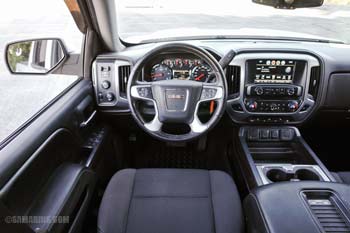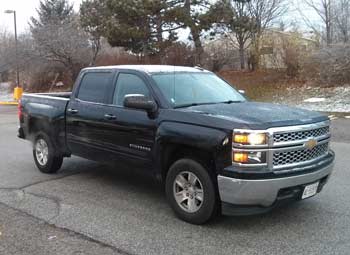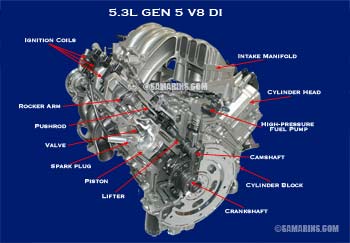2014-2018 GMC Sierra 1500: problems, 5.3L V8 engine
By Vlad Samarin March 27, 2020
The GMC Sierra 1500 is a great choice for those looking for a capable full-size truck that is comfortable to drive.
The Sierra is available as a Regular Cab, Extended (Double) Cab or Crew Cab (in the photo).
Engine choices include a 4.3-liter V6, 5.3-liter V8, and 6.2-liter V8. Transmission choices are the 6-speed automatic (6L80) or the 8-speed automatic (8L90).All models are available with either rear-wheel or four-wheel drive. The Sierra offers a comfortable ride, plenty of power, and a variety of available features.
The Sierra has a good reputation, although there are several weak spots that used car buyers should watch out for. Here, we focus on the Sierra 1500, but the Chevy Silverado 1500 is the same vehicle with a few minor differences.
Reported problems:
Headlights: we noticed that there are quite a few complaints on the NHTSA website about headlights not providing adequate lighting at night in the 2014, 2015 Sierra.General Motors issued the Service Bulletin PIT5374 that recommends checking the headlights and reprogramming the BCM (Body Control Module) with the latest calibration, as well as replacing both headlight bulbs with updated bulbs.
If you are shopping for a used 2014-2015 GMC Sierra, check if the headlights are bright enough. The Chevy Silverado 1500 doesn't have this issue due to different headlight design.
Bad ground connection can cause various electrical issues: If you have a problem with headlights or any other electrical issues, some of the things that should be checked first are the ground connections and the battery terminals.
GM issued Service Bulletin 18-NA-161 for several models including the 2014 GMC Sierra that describes various problems that can be caused by a bad ground connection or loose battery terminals.
These include: Service Stabilitrak message, stalling, no-start, displays go blank, steering wheel jerks or kicks back when turning, alarm issues or wipers continue running after turning off. Here is the link to the bulletin at the NHTSA website; it shows photos and explains what to check for mechanics.
From our experience, we know that a corroded/loose ground connection can cause many electrical issues. Watch these Youtube videos to have an idea.
A/C Not working: The one common thing that can cause the air conditioner not to work is a leaking A/C condenser, especially in the 2014 and 2014 model years.
The condenser is a heat exchanger located in front of the radiator behind the grille. Sometimes you can actually see through the grille an oily spot or a greenish residue on the condenser itself, typically on the driver's side. It is a common sign of A/C refrigerant leak.
The good news that replacing the A/C condenser is not very difficult (1.0-1.2 hours of labor in the shop), aftermarket parts are not too expensive and any shop working with A/C can handle this repair. If the leak is not obvious, your mechanic will have to do some testing; for example, adding a leak detection dye into the system, recharging it and testing for leaks.
Other potential leak spots include A/C lines, joints and the compressor. Here is a good video that explains replacement of the A/C condenser. If you are buying a used GMC/Chevy truck, test the A/C in all modes.
5.3L V8 Code P0300: The truck may run rough and the Check Engine light will stay on or sometimes flash on and off. The scan may reveal the trouble code P0300 - random misfire.
Common causes of this code include old spark plugs and wires, a bad ignition coil, bad fuel injector, carbon buildup on the injectors and intake valves. A dirty throttle body, a vacuum leak (e.g., from intake manifold gasket) or even a bad ground connection can also cause this code.
Mechanics use advanced scan tools that can show the misfire count of each cylinder, making the diagnosis easier. Here is a good Youtube video explaining the diagnosis; the suspected cause is excessive carbon buildup.
We found this GM service bulletin 16-NA-383 for you; it also mentions that the code P0300 can be caused by major carbon build up. If confirmed by the diagnosis and there is no valve damage, the bulletin advises to perform an upper engine and valve cleaning procedure. The best place to get it done is your local GM dealer.
This Youtube video shows a bad ground connection that can cause cylinders on one side of the engine not to work.
This Youtube video also have a good explanation of possible bad ground connection and bad ignition coil causing the code P0300.
The code P0446: This code is related to the EVAP system. One common failure part is the EVAP canister vent solenoid valve (CVS) that is located at the EVAP canister. A problem with the purge valve can cause this code too.
Your mechanic will have to do some testing of the EVAP system with a scan tool. The vent tube that goes out from the EVAP canister towards the filler neck has a filter that needs to be checked for blockage. The service bulletin 15-06-04-002 for the 2014 Sierra 1500 recommends if the CVS valve is the cause, replacing it with an updated design. A vent valve or a purge valve are not too expensive to replace.
Vibration at highway speeds: (Google 'Chevy shake'). The first thing to try is to balance all 4 tires; it may help in some cases. Tires also need to be checked for runout. For example, watch this video.
Another thing that can potentially cause vibration is the driveshaft. Some GM truck owners even suggest upgrading the driveshaft with a heavy-duty part. For the 8-speed transmission, GM recommends changing the transmission fluid, see the bulletin 18-NA-355 (link below).
Transmission issues: Consumer Reports rates the transmission reliability 'below average' for all model years of this generation of the Sierra/Silverado 1500. However, many owners report that some transmission problems have been repaired while under warranty. In the 6-speed 6L80 transmission many problems are caused by the torque converter. There are several ways to address transmission problems:
1. When buying a used Sierra, watch out for slipping, shudder, harsh shifting and other transmission issues during the test drive. Consider buying an extended powertrain warranty that will cover engine or transmission repairs. We recommend an extended warranty that doesn't have a low limit per claim (e.g., $1000 per claim) as replacing the transmission can cost over $4,000.
2. Change the transmission fluid more often using recommended fluid at your GM dealer. For example, the GM service bulletin 18-NA-355 for the 8-speed 8L90 transmission recommends flushing the transmission to fix 'Shake and/or Shudder During Light Throttle Acceleration Between 25 and 80 MPH'. If you have the 6-speed transmission check if the TSB 21-NA-199 has been done to your truck, as it helps to keep the transmission cooler. Scroll down for the link to the TSB.
3. Periodically check with the dealer or your mechanic if any new software is available for the transmission control module (TCM) or for the transfer case module. Some shift issues can be fixed with update software. There is also procedure called 'Transmission Service Fast Learn' or SFL that needs to be performed after some of the transmission repairs and software updates; it allows the TCM to learn individual clutch characteristics to improve shifting.
4. If you feel that your transmission starts having some issues, have it checked out, as if the problem is caught early, the repair might be less costly. Watch out for transmission fluid leaks (e.g./ from cooler lines or extension housing), so that you can catch the leak before a lack of fluid can cause problems.
5. Many transmission shops offer upgrading your transmission with modified parts/software to make it last longer. One example is an upgraded transmission fluid cooler. If you are interested in something like this, check YouTube and GM truck forums, there are many discussion on this topic. Ask your local transmission shop.
Some of the service bulletins related to the transmission:
PIP5175D 6L80 Slip Or Shudder During A Launch In First Second Third Or Fourth Gears Delayed Engagement Into Drive Clunk Or Bump During The 1-2 Shift.
21-NA-199 6L80 Installation of a New Thermal Bypass Valve (TBV) that has cooler operating temperature.
18-NA-355 8L90 Shake and/or Shudder During Light Throttle Acceleration Between 25 and 80 MPH (40 and 128 KM/H) at Steady Speed.
16-NA-014 8L90 describes the delayed engagement after sitting with engine Off.
Summary:
The 2014-2018 GMC Sierra 1500 and its sibling Chevrolet Silverado 1500 are capable trucks. We would even recommend this generation over the next one, mainly because of engine lifter issues in the 2019+ models. In terms of maintenance, bad gasoline and lack of oil changes can cause problems.As we mentioned above, the transmission needs a particular attention. Overall, it's a good-looking truck that is a pleasure to drive, especially if you have an extended powertrain warranty for peace of mind.
If the long-term reliability is a priority for you, we recommend the Toyota Tundra; of course, it's a bit more expensive. If you are buying the GMC Sierra/Chevy Silverado 1500, we found many Youtube videos offering tips on how to make it last longer; check them out.
5.3L V8 L83 355-hp Engine: It's a Generation 5 OHV (overhead valve) small block V8 from the EcoTec3 engine family. It has a cast aluminum cylinder block and the head, 2 valves per cylinder, variable valve timing and direct fuel injection with active fuel management (AFM).
Direct Injection or DI means that fuel is injected directly into the combustion chambers under a very high pressure. DI makes the engine more fuel efficient. One of the drawbacks of direct injection is carbon buildup on intake valves and injectors at higher mileage.
Some owners recommend installing a catch can (oil separator) that will separate oil from oil vapors before they got sucked into the intake. This may help reduce carbon buildup.
Active Fuel Management temporarily deactivates four of the cylinders on the V8 engines under light load conditions. This also helps improve fuel efficiency. The downside is a more complicated design of the engine and as a result more problems, for example, with the lifters.
What to watch out for when buying a used GMC Sierra/Chevy Silverado 1500: Test the A/C to make sure it works well. Avoid the truck if the Check engine light is on or if the engine is too noisy (e.g., lifter noise).
The transmission needs to be checked carefully. Some transmission issues are more obvious when the vehicle is started first thing in the morning and the transmission is cold, especially with the 8-speed transmission. Other transmission flaws become noticeable only after the transmission is fully warmed up. This means that if possible, you may want to test drive when the truck is cold and then after it is fully warmed up.
Watch out for delayed engagement and any kind of shudder during acceleration, slipping, jolts, or harsh shifting during the test drive. Sometimes you may feel like if the transmission goes into Neutral while driving. If you feel that there is something wrong with the transmission, avoid the truck. When driving at highway speeds, watch out for vibration.
If there is an unpaved road, test all 4WD modes. Watch out for noises. See if the transfer case is not sticking in 4WD mode. Watch out for signs indicating that the truck was used for towing a heavy trailer. In this case, the transmission is also more likely to be worn out.
Consider buying an extended warranty for the powertrain.
Check the NHTSA website for recalls.



